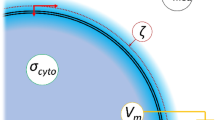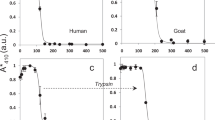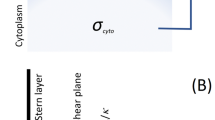Abstract
IT is well known that the membrane of red cells is very permeable to Cl− and other anions1. Tosteson has shown, by making radioisotope measurements, that Cl− enters the red cell in less than 1 s (ref. 2). Theoretical treatments of the mechanism of swelling3 of the red cells have assumed implicitly a high rate of diffusion of anions into the cells. Consequently, the increase in water content has been quantitatively related to diffusion of cations through “leaks” in the membrane. The rate of diffusion of anions through the red cell membrane, however, has never been measured accurately. Because of the restriction of electro-neutrality, as long as the red cell membrane has a low permeability to cations as assumed by the “pump and leak” hypothesis, the experimental conditions used by Tosteson2 are suitable for measuring the rate of exchange of anions, but not the rate of net translocation of anions through the red cell membrane. Only when high and specific permeability of the red cell membrane to cations is established can the rate of diffusion of anions through the membrane be determined. Such conditions now seem to be fulfilled by the antibiotic gramicidin which has been reported to render different types of biological membranes and artificial phospholipid bilayers5 highly permeable to univalent cations. When gramicidin was first used on red cells, however, the result was unexpected. Chappell and Crofts4 reported that addition of gramicidin to a suspension of red cells in isosmotic choline chloride caused efflux of K+ and uptake of H+ in a 1:1 ratio. If the red cell is highly permeable to Cl−, an efflux of Cl− without alkalinization of the medium might be expected. Chappell and Crofts reported no data on the movement of Cl− and water. We report further data on the permeability of the red cell membrane to anions, obtained with the aid of the specificity of gramicidin.
This is a preview of subscription content, access via your institution
Access options
Subscribe to this journal
Receive 51 print issues and online access
$199.00 per year
only $3.90 per issue
Buy this article
- Purchase on Springer Link
- Instant access to full article PDF
Prices may be subject to local taxes which are calculated during checkout
Similar content being viewed by others
References
Passow, H., in The Red Blood Cell (edit. by Bischop, C., and Surgenor, D. M.), 71 (Academic Press, 1964).
Tosteson, D. C., Acta Physiol. Scand., 46, 19 (1967).
Tosteson, D. C., and Hoffman, J. F., J. Gen. Physiol., 44, 169 (1960).
Chappell, B. C., and Crofts, A. R., in BBA Library, Regulation of Metabolic Processes in Mitochondria (edit. by Tager, J. M., Papa, S., Quagliariello, E., and Slater, E. C.), 7, 293 (Elsevier, 1966).
Chappell, B. C., and Haarhoff, K. N., in Biochemistry of Mitochondria (edit. by Slater, E. C., Kaniuga, Z., and Wojtczak, L.), 75 (Academic Press, 1967).
Passow, H., Cottoq. Ges. Physiol. Chem., Mosbach/Baden (1961).
Author information
Authors and Affiliations
Rights and permissions
About this article
Cite this article
SCARPA, A., CECCHETTO, A. & AZZONE, G. Permeability of Erythrocytes to Anions and the Regulation of Cell Volume. Nature 219, 529–531 (1968). https://doi.org/10.1038/219529a0
Received:
Revised:
Issue Date:
DOI: https://doi.org/10.1038/219529a0
This article is cited by
-
Characteristics of anion transport in cat and dog red blood cells
The Journal of Membrane Biology (1979)
Comments
By submitting a comment you agree to abide by our Terms and Community Guidelines. If you find something abusive or that does not comply with our terms or guidelines please flag it as inappropriate.



